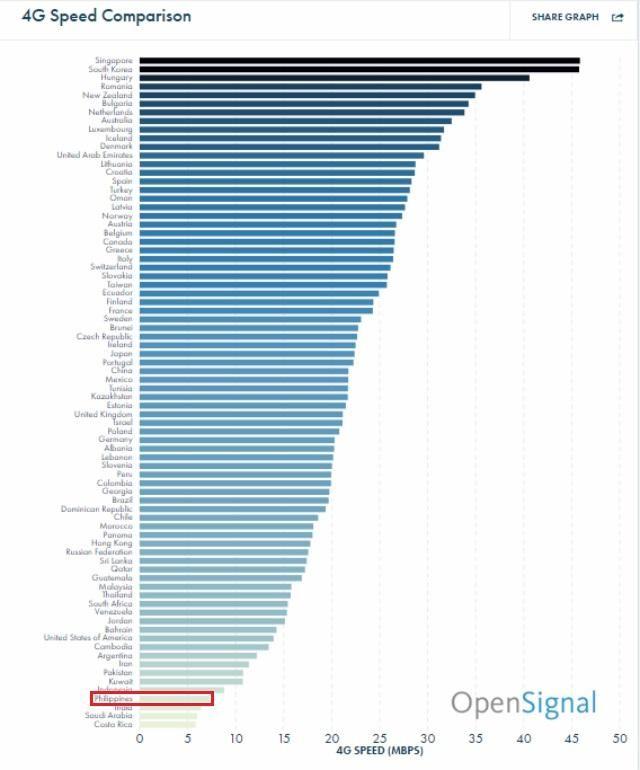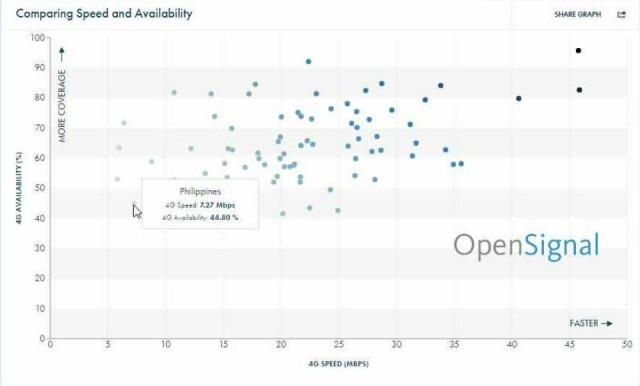PHL's LTE internet services still among world's worst, data shows

Over half a decade since the Philippines first obtained LTE or 4G technology, the country still lags behind most of the world in its use.
A new survey from mobile service watchdog OpenSignal shows that the Philippines is far outpaced by most other countries' mobile internet providers in terms of both download speed and service availability.
OpenSignal found that LTE/4G internet connectivity in the Philippines is among the slowest in the world, and is only available to subscribers less than half of the time.
OpenSignal's sampling methodology
OpenSignal's latest report as of November 2016 claims to have sampled over 17 billion measurements by over 500,000 users around the world of the company's mobile internet speed testing app.
The report focused on LTE/4G usage worldwide from July 1 to September 30, looking at average download speeds per country as well as internet "availability"—that is, how easy it is for subscribers to access high-speed mobile data services.
"OpenSignal's availability metric tracks the proportion of time users have access to a particular network. For example, if a country has 50% 4G availability, then on average that country's 4G users can find an LTE signal half of the time," the company explained.
Average download speed
OpenSignal found that the Philippines ranked 75th out of 78 countries in terms of average 4G/LTE download speed, faring only slightly better than India, Saudi Arabia, and Costa Rica.
The Philippines clocked in an average download speed of 7.27Mbps, a sorry laggard behind Singapore's world-leading 45.9Mbps. The global mean is 17.4Mbps, according to OpenSignal.

Availability of service
In terms of availability, the Philippines also fared worse than most of the world, ranking 74th out of 78 countries ahead of Ireland, Ecuador, Lebanon, and Sri Lanka.
According to OpenSignal, mobile internet users in the Philippines could only access 4G/LTE services 44.8% of the time. In contrast, South Korea led the world in terms of LTE availability at 95.7%, according to OpenSignal.

The big picture
Looking at these metrics together across countries paints a bleak picture for the Philippines, whose high-speed internet services seem to have stagnated in one way or another versus other nations.
On the one hand, although India, Saudi Arabia, and Costa Rica lag behind the Philippines in terms of internet speed, these countries make up for their sluggishness by being able to provide LTE/4G more than half of the time.
On the other hand, Ireland, Ecuador, Lebanon, and Sri Lanka are less able than the Philippines to provide LTE/4G services but make up for this by being at least on par with the global average of 17.4Mbps.

"Countries higher up and toward the right in the chart (above) have both fast LTE networks and a high proportion of LTE signals, reflecting more developed 4G infrastructures. Countries in the lower-left hand side of the graph are typically in the early stages of their LTE rollouts," OpenSignal explained.
Half a decade of little change
However, OpenSignal notes that the Philippines has officially had LTE capability for over half a decade, since April 2011.
And even before then, at the start of that same year, GMA News Online published a report which showed that the Philippines lagged behind two-thirds of the world in terms of internet broadband download speed—ranking 139th out of 185 countries, outstripped by even the diminutive African nation of Rwanda. — GMA News




